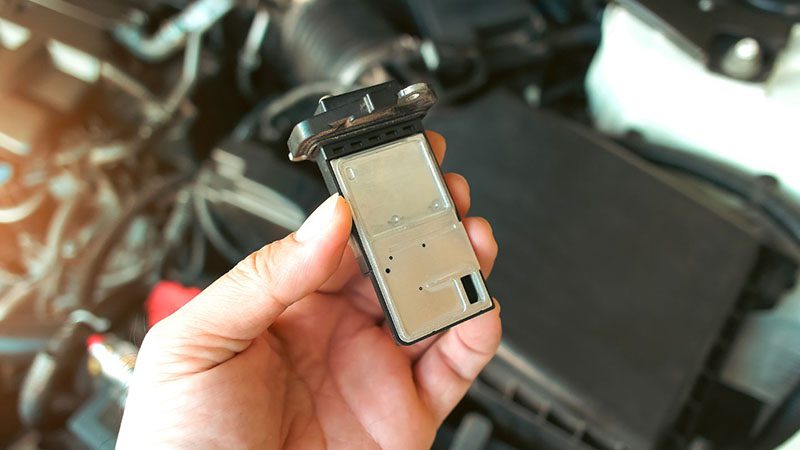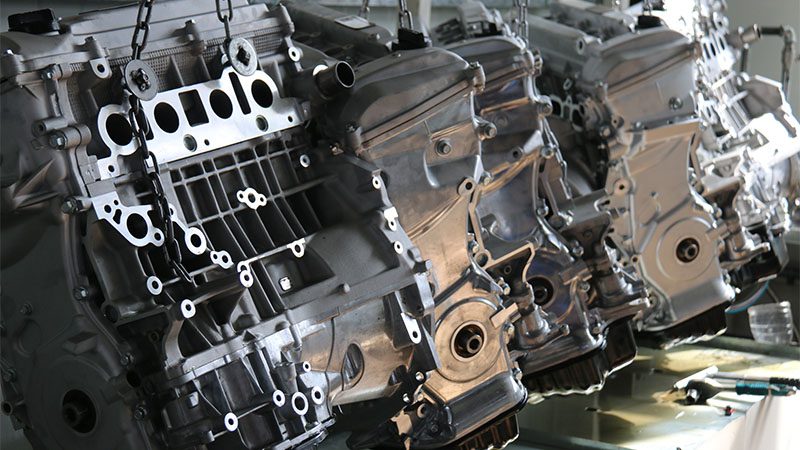Ever noticed your car struggling with fuel efficiency? Maybe it’s hesitating when you accelerate, idling rough, or even stalling unexpectedly. If you’re experiencing these issues, your Mass Air Flow (MAF) sensor could be the problem.
This little guy plays a big role in making sure your engine runs smoothly. It measures the amount of air going into the engine and helps regulate the air-fuel mixture for optimal performance. When it fails, it can cause poor gas mileage, slow acceleration, black smoke from the exhaust, and even long term engine damage.

In this guide we’ll cover everything you need to know about the MAF sensor—how it works, why it’s important and how to clean, troubleshoot or replace it if needed.
What Is a MAF Sensor?
A MAF sensor is an electronic component located between the air filter and the engine’s intake manifold. Its job is to measure the air going into the engine and send that data to the engine control module. The engine control module then uses that information to adjust the fuel injection for the perfect air-fuel mixture.
Why does this matter? Because your engine needs the perfect air to fuel ratio to run efficiently. If there’s too much air and not enough fuel (running lean) the engine can misfire, lose power and overheat. If there’s too much fuel and not enough air (running rich) it can cause excess fuel consumption, carbon buildup and increased emissions.
A working MAF sensor ensures your engine gets the right balance of air and fuel, so your car runs smoothly and maximizes fuel efficiency.

How Does a MAF Sensor Work?
The MAF sensor measures both air volume and density as it flows into the engine. It then sends that data to the engine control unit which adjusts the fuel injection accordingly.
Types of MAF Sensors
There are two main types of MAF sensors:
1. Hot Wire MAF Sensor – The most common type in modern vehicles. It has a tiny, electrically heated wire. As air flows past it, the wire cools and the ECU measures how much electrical current is needed to keep it at the right temperature. This change in current tells the ECU how much air is entering the engine. Some hot wire MAF sensors also integrate an intake air temperature sensor to provide more accurate data for the ECU.
2. Vane Meter MAF Sensor – Found in older vehicles, this type uses a mechanical flap that moves with the incoming air. The position of the flap determines the airflow reading sent to the ECU.

Why Is the MAF Sensor Important?
A properly functioning MAF sensor ensures:
✅ Optimal fuel efficiency – Reduces excessive fuel consumption.
✅ Smooth acceleration – Prevents hesitation and throttle response issues.
✅ Lower emissions – Helps maintain a proper air-fuel ratio.
✅ Engine protection – Prevents misfires, rough idling, and damage from running too rich or too lean.
When the MAF sensor fails, it can cause serious issues like poor gas mileage, sluggish acceleration, and black smoke from the exhaust.

Symptoms of a Bad MAF Sensor
A failing MAF sensor can cause several noticeable symptoms:
- Check Engine Light (CEL) – A faulty sensor can cause the ECU to register an error code such as P0101 (MAF sensor performance issue), P0102 (low input), or P0103 (high input) which may illuminate the Check Engine Light.
- Poor Fuel Economy – If the sensor is misreading airflow the ECU may inject too much fuel and cause excess fuel consumption.
- Engine Stalling or Hesitation – An incorrect air-fuel mixture can cause the engine to stall at idle, hesitate under acceleration or have delayed throttle response.
- Black Smoke from Exhaust – If the engine is running too rich you may see black smoke from the exhaust, unburned fuel being expelled.
If you experience any of these symptoms cleaning or replacing the MAF sensor may be necessary.

Diagnosing MAF Sensor Problems
Diagnosing issues with your mass air flow sensor can be a bit tricky, but it’s crucial for maintaining optimal engine performance and fuel efficiency. Here’s a step-by-step guide to help you pinpoint the problem:
1. Check the Dashboard Warning Lights: If your Check Engine Light (CEL) is on, it could be a sign of a faulty MAF sensor. Use a code reader to pull the trouble codes and identify the issue.
2. Monitor Engine Performance: Pay attention to how your engine is running. Symptoms like rough idling, stalling, or hesitation during acceleration can indicate a malfunctioning MAF sensor.
3. Inspect the Air Filter: A dirty or clogged air filter can lead to MAF sensor issues. Ensure your air filter is clean and replace it if necessary to prevent airflow restrictions.
4. Visual Inspection of the MAF Sensor: Look for any visible signs of damage, corrosion, or contamination on the MAF sensor. Also, check the wires and connectors for any signs of wear or damage.
5. Use a Multimeter: Test the MAF sensor’s voltage output with a multimeter. Compare the readings to the manufacturer’s specifications to determine if the sensor is functioning correctly.
6. Perform a Smoke Test: Conduct a smoke test to identify any vacuum leaks or issues with the intake manifold that could be affecting the MAF sensor’s performance.
7. Consult a Repair Manual: If you’re unsure about any step, refer to the repair manual specific to your vehicle’s make and model for detailed instructions.
By following these steps, you can accurately diagnose and address any issues with your MAF sensor, ensuring your engine runs smoothly and efficiently.

How to Clean a MAF Sensor (Step-by-Step Guide)
A dirty MAF sensor can cause inaccurate airflow readings and affect engine performance. Cleaning it regularly can restore function and prevent costly replacements.
When to Clean vs. Replace?
- Clean the sensor if you notice performance issues but no physical damage.
- Replace it if cleaning doesn’t fix the issue or if it’s cracked, broken or continuously triggering error codes.
Tools Needed:
✔ MAF sensor cleaner spray (specifically designed for MAF sensors)
✔ Screwdriver (for removal)
✔ Gloves (for protection)
Cleaning Steps:
1. Locate the MAF sensor – Usually found near the air intake tube, after the air filter.
2. Disconnect the sensor – Carefully unplug the electrical connector and unscrew the sensor.
3. Spray MAF cleaner – Hold the sensor upright and spray MAF sensor cleaner directly onto the sensor wires. Do not touch or scrub the wires.
4. Let it dry completely – Wait at least 10–15 minutes before reinstalling.
5. Reinstall the sensor – Securely place it back in position and reconnect the wiring.
⚠ Warning: Never use water, compressed air or household cleaning agents as they can damage the sensor wires.

MAF Sensor Replacement Guide
If cleaning the MAF sensor doesn’t fix the issue, replacement may be necessary.
Signs It’s Time to Replace the MAF Sensor
- The sensor still triggers error codes after cleaning.
- Engine performance issues persist (stalling, rough idling, poor fuel economy).
- Visible damage to the sensor (cracked or corroded components).
How to Replace a MAF Sensor
1. Turn off the engine and disconnect the battery (to reset the ECU).
2. Unplug the old MAF sensor and carefully remove it.
3. Install the new sensor and secure it properly.
4. Reconnect the sensor and battery.
5. Reset the ECU (if necessary) and test drive the vehicle to ensure proper function.

Future of MAF Sensors
As automotive technology advances, MAF sensors are becoming more sophisticated, contributing to better fuel efficiency, lower emissions, and enhanced engine performance.
Automakers and sensor manufacturers are continuously innovating to improve accuracy, durability, and adaptability to meet the evolving needs of modern vehicles.
🔹 Digital MAF Sensors – More precise and durable than traditional sensors, reducing failure rates.
🔹 AI-Driven ECUs – Artificial intelligence is optimizing fuel-air mixture for maximum efficiency.
🔹 Hybrid & Electric Vehicle Adaptations – While EVs don’t need MAF sensors, modern airflow monitoring is crucial for battery cooling and performance optimization.

In the future, MAF sensors will continue to be vital for internal combustion engines and hybrid systems, evolving to provide even more precise data for advanced engine control systems.
Conclusion
The Mass Air Flow (MAF) sensor is essential for maintaining the right air-fuel mixture, ensuring optimal engine performance, fuel efficiency, and emissions control. If the MAF sensor fails, it can lead to poor acceleration, rough idling, high fuel consumption, and even engine stalling. While regular cleaning can help, replacing a damaged sensor is crucial for keeping your vehicle running smoothly.
The MAF sensor is undeniably vital, but maintaining your engine takes more than just that—it depends on high-quality components to perform at its best.

At Nanjing Woda Auto Technology Co., Ltd., we specialize in OEM and aftermarket engine parts, offering a wide range of cylinder heads, crankshafts, camshafts, and other critical components. We provide trusted, reliable solutions to auto parts dealers and repair shops worldwide. Contact us today for more information!





